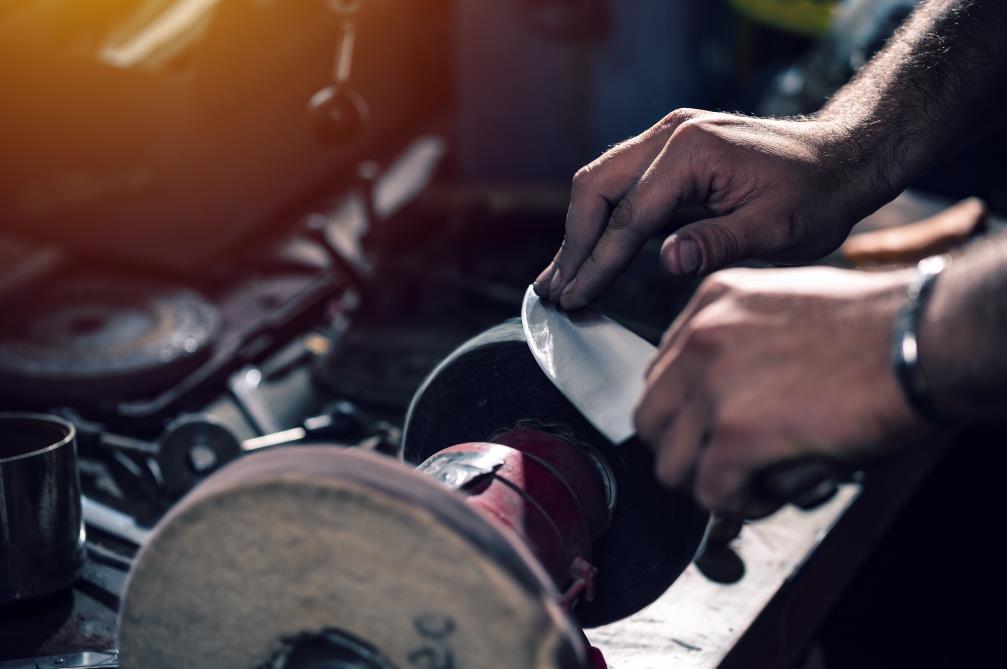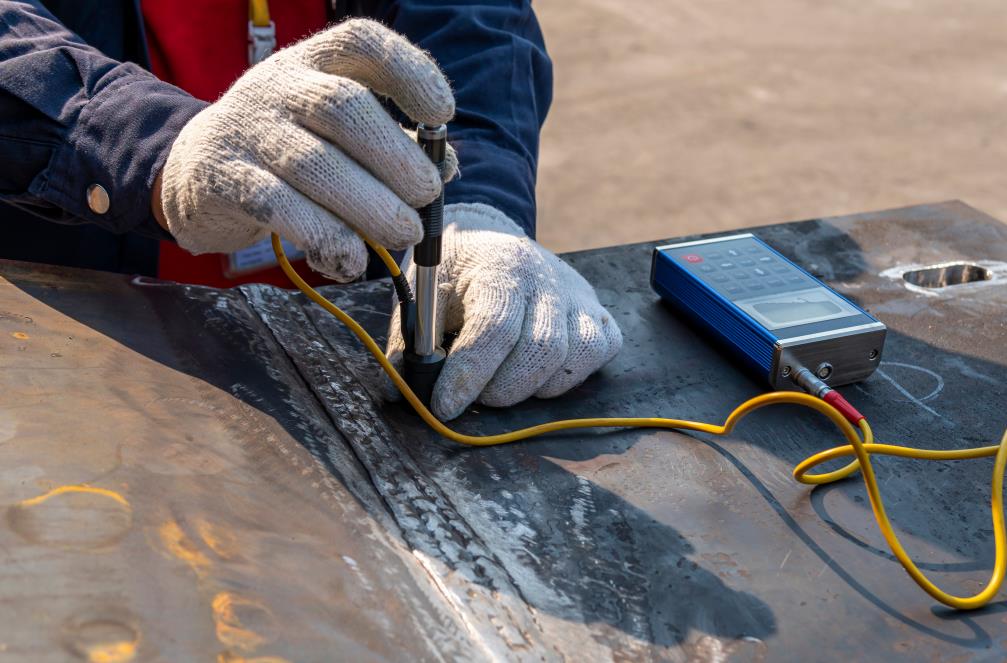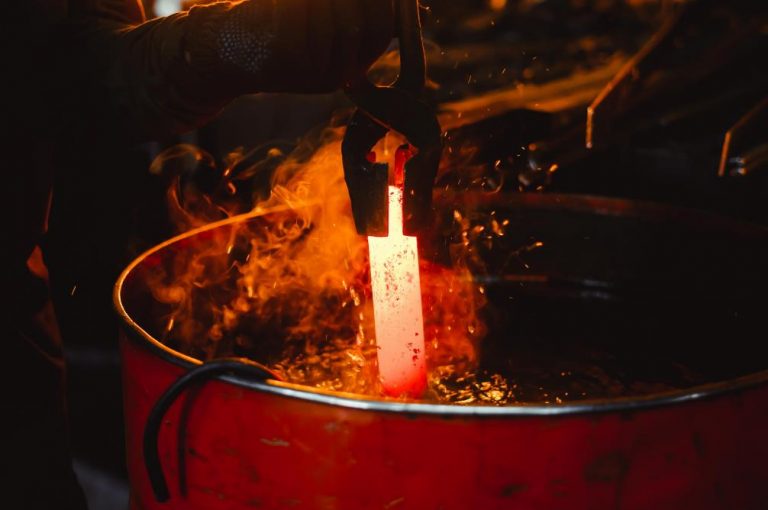The industry standard for measuring the hardness of metals is the Rockwell hardness scale. In the knife world, the Rockwell hardness rating can tell a lot about a blade’s features and what to expect from it, as hardness dictates a lot of the knife’s performance.
Different metals follow a distinct procedure to measure hardness. Since almost all blades are made from steel, Scale C is what matters to us. The hardness rating of steel is indicated in several ways – HRC, HRc, RC, Rc, and variations of these three letters.
However, this isn’t an indication of the hardness. It merely tells us the hardness testing was performed through Rockwell hardness testing. What matters is the numbers that come before or after them.
How does the Rockwell hardness testing work?

The Rockwell hardness test is relatively straightforward, but it requires special machinery. So it’s not a test that anyone can perform in their garage or workshops.
A sphero-conical diamond indenter and precise measuring are needed to calculate the steel’s hardness. Here is how the Rockwell hardness testing works in simple steps.
- The diamond indenter pushes into the steel with a 10 KG of force (KGF). The depth created with this is taken as the first reference point.
- The diamond indenter pushes into the steel again but with 140 KGF this time. This is the major load.
- It is then reduced back to 10 KGF. The depth created with a total of 150 KG of force is taken as the second reference point.
- The difference between the first and the second reference points reveals the Rockwell hardness rating of the steel.
This process is automatic and doesn’t damage the steel. There becomes a tiny dent where the machine creates the depth, but it doesn’t affect the blade as a whole.
Most Rockwell hardness testing machines cost upwards of $6,000. Because it isn’t accessible to everyone, most custom knifemakers take the hardness of the steel used for forging the blade as the knife’s hardness.
At LeeKnives, we combine our fine craftsmanship with the latest technology to ensure everything is accurate and flawless. Visit our service page to see the offers to retailers and wholesalers. Small or big, we are dedicated to helping all our partners regardless of their order size to ensure growth.
Buy Wholesale Knives and Start Scaling up with Us Today
Contact us and connect with a sales rep to get a free quote.
What do the HRC numbers mean?
The HRC numbers are what’s important. They indicate the steel’s hardness. Some knives display their Rockwell hardness rating on the packaging. Knowledgeable customers can see how hard the steel the blade is made from to shape an idea of what to expect from it.
As for the hardness, the knife blades with hardness between HRC 45 and low-50s are considered soft. Any steel above the mid-50s is considered hard, but going above 58 to 60, that’s where we regard them as very hard. Since the testing is the same for all types of steel, it applies to any, not just those used for forging blades.
Is the scale important to knives?

The Rockwell hardness rating is critical, as it’s the standard way to understand the blade’s hardness. It gives a great idea about the knife’s ability to keep a sharp edge, durability, sharpening ease, and more.
For example, knife steel above 60 HRc tends to be more brittle. Each number that goes above 60 only increases this.
However, it isn’t just brittleness the hardness determines. The knife blades made from hard steel hold a sharp cutting edge that continues cutting significantly more than softer alternatives. They also have better wear resistance, which means it doesn’t show as many scratches on the surface.
These traits are typical for hard steel and tend to be the opposite of soft steel. Because the hardness changes a lot of the knife’s features, knowing the HRc rating of the blade can help acquainted shoppers pick the right product for them.
How does the forging/heat-treating process change the steel hardness?
By standard, all steel has maximum hardness. How hard steel can get primarily depends on its carbon content and other alloying elements that contribute to hardenability.
A specific steel can achieve its maximum hardness through different heat treatment techniques suitable for it. While this improves hardness drastically, it can negatively affect the steel’s overall performance as a knife blade. When the hardness is increased more than the steel’s optimal range, it becomes too brittle.
For example, ZDP-189 is one of the hardest steels with a usual hardness of HRc 65. This steel can get as hard as HRc 70 through quenching in dry ice. Since this hardness is significantly higher than its standard, it becomes too brittle. At this point, cutting through anything slightly dense, even like medium-sized fish bones, risks chipping the edge. Therefore, heat-treating to maximum hardness generally doesn’t result in satisfactory outcomes.
Instead, a good way to have a balanced hardness is by heat-treating the steel close to its maximum hardness. Then, temper at lower temperatures for different periods to reduce excess hardness. By eliminating the excess, hard steel becomes tougher and resists damage better.

Popular knife steels and their hardness under the Rockwell test
Here is a quick overview of popular knife steels and how they measure in the Rockwell hardness test.
| Hardness | Edge Retention | Wear Resistance | Toughness | Ease of Sharpening | |
| 440C | 58 – 60 HRc | 6/10 | 6/10 | 6/10 | 7/10 |
| 1095 | 55 HRc | 5/10 | 5/10 | 8/10 | 8/10 |
| AUS-8 | 59 HRc | 6/10 | 6/10 | 7/10 | 7/10 |
| VG-10 | 57 – 60 HRc | 7/10 | 7/10 | 5/10 | 7/10 |
| S30V | 57 – 61 | 6/10 | 7/10 | 5/10 | 6/10 |
| ZDP-189 | 65 HRc | 9/10 | 8/10 | 2/10 | 2/10 |
Learn more about different knife steels.
How to choose the appropriate steel hardness?
The table above makes it evident that the hardness can positively or negatively impact certain properties. That’s why any seller needs to settle on the appropriate hardness range to satisfy their customers.
For example, you can expect the blade to be incredibly durable against chips with low hardness. These knives can endure constant heavy impacts. Any outdoor person constantly turning to their knives to cut small wood pieces or cooks that cut dense bones can benefit from a blade like this. However, these blades require a more frequent sharpening routine as they get dull faster.
The high hardness improves edge retention and wear resistance, enabling the blade to keep a sharp edge for longer. At the same time, these knives are less durable despite being harder. After a certain hardness level, the steel starts to become brittle. These knives are better for general slicing work that doesn’t demand much toughness.
Rockwell hardness measurement for other metals

The different Rockwell hardness testing methods for various materials follow a distinct indenter and force. Here are some of the popular Rockwell hardness scales used for materials other than knife steel.
- Scale A measures the hardness of shallow case-hardened steel and cemented carbides. The indenter and the measuring process are the same as Scale C, but instead of a total of 150 KGF, the load is 60 KGF.
- Scale B measures the hardness of copper and aluminum alloys and malleable iron with a 1.59mm ball indenter with a total of 100 KGF.
- Scale E is mainly used for measuring the hardness of cast iron. It requires a 3.18mm ball with 100 KGF applied to the steel. Scale E is also suitable for testing the hardness of thermoset plastics and bearing metals.
- Scale H measures the hardness of zinc, lead, and aluminum with a 3.18mm ball by applying 60 KGF.
- Scale K measures the hardness of hard plastic but is also utilized for tin. The indenter is the same as Scale E and H. The force, however, is 150 KGF, the same as Scale C.
Other hardness measurements
Rockwell hardness scale isn’t the only reference point for measuring the hardness of different materials. Regardless of the testing, the principle is the same. Here are a few of the other, rather less preferred hardness measurements.
Brinell system
Brinell hardness measurement uses the same procedure as any other hardness measurement. It uses an indenter applying a specific force to measure the permanent depth created. Depending on the material tested, the indenter for Brinell testing can be a tungsten sphere or hardened steel ball.
However, Brinell hardness measurement is more for incredibly hard materials. It uses a 10mm carbide ball with a total force of 3,000 KGF. Because of the force applied, Brinell hardness measurement isn’t as preferred for measuring the hardness as it’s too destructive to the blade.
Vickers
The same as the others, Vickers hardness follows the same process. However, the indenter doesn’t change across different materials. This convenience makes the Vickers hardness test easier to perform than Brinell or Rockwell hardness test.
The way the Vickers test shows the hardness is somewhat different than others. Though it may look rather complicated, it displays more information than the Rockwell hardness measurement.
Example: 510HV50/10
The 510HV refers to the hardness, while 50 refers to the load in KGF, and 10 indicates the time under tension.
Conclusion
Rockwell hardness testing’s Scale C is the most proper way to tell a blade’s hardness. Although there are others, they are either too destructive or don’t provide adequate measurement for knife blades.
The steel used for forging the blade changes the blade’s hardness and other characteristics. Read on different knife steels from the LeeKnives blog to learn more about them.
Contact us with any questions you have in mind. We utilize various steels for different purposes catered to meet the needs of your customers.







